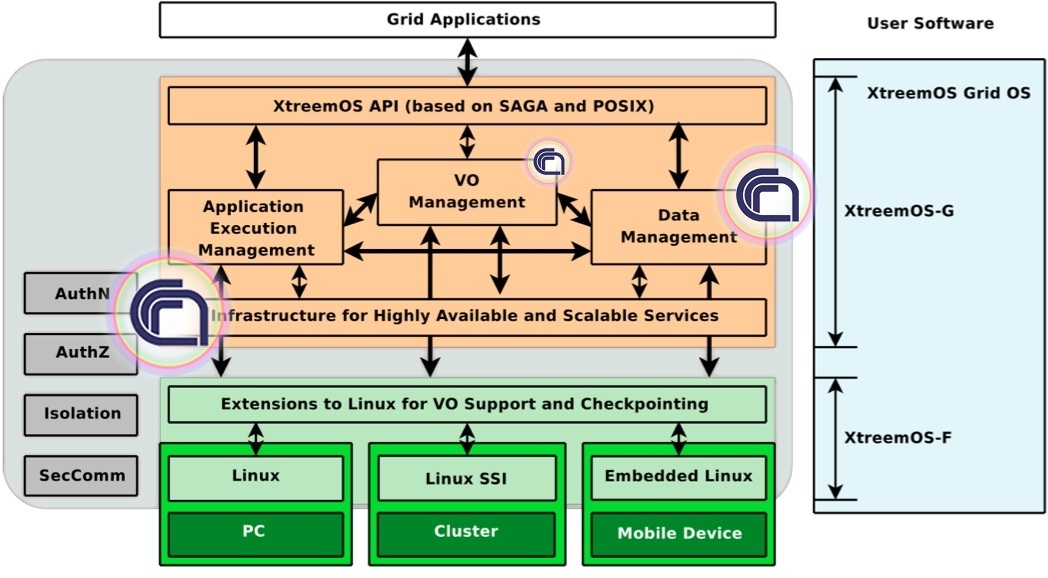service scalability and high availability
2009-06-19
Get acquainted with one XtreemOS partner: Consiglio Nazionale delle Ricerche (CNR)
Consiglio Nazionale delle Ricerche (CNR)
 The Italian National Research Council (CNR) is a public organization whose purpose is to carry out, promote, and improve research activities in the main sectors of knowledge, spread their results and help their transfer to the industry and their application, to further the scientific, technological, economic and social development of Italy. To this purpose, a network of CNR institutes is distributed all over Italy. To promote international cooperation and contribute to the development of key technologies, CNR participates in agreements, contracts and research projects with the European Union and with the other international organizations; among them the CNR membership of ERCIM and of W3C. Two of the CNR institutes, ISTI and ICAR, are involved in the development of XtreemOS.
The Italian National Research Council (CNR) is a public organization whose purpose is to carry out, promote, and improve research activities in the main sectors of knowledge, spread their results and help their transfer to the industry and their application, to further the scientific, technological, economic and social development of Italy. To this purpose, a network of CNR institutes is distributed all over Italy. To promote international cooperation and contribute to the development of key technologies, CNR participates in agreements, contracts and research projects with the European Union and with the other international organizations; among them the CNR membership of ERCIM and of W3C. Two of the CNR institutes, ISTI and ICAR, are involved in the development of XtreemOS.
CNR's contributions to XtreemOS
Scalable, Highly available services
Within XtreemOS, the CNR team is involved in the development of the highly available services that tie up into a system the XtreemOS individual machines on a grid. CNR has developed the Service/Resource Discovery System (SRDS), that leverages on overlay networks and exploits the functionalities of the XtreemFS-F basic layer of XtreemOS,
The SRDS daemons run distributed over the nodes of the XtreemOS platform, and offer resource and service discovery services to other XtreemOS modules and applications. SRDS resolves key-based and range-based queries, over both dynamic and static information. The main clients of the SRDS are currently the Application Execution Management (AEM) and the Job Directory Service (JDS) modules. They access information about computing resources and running jobs within a Virtual Organization.
The SRDS layered architecture employs a combination of overlay networks and query resolution algorithms to improve on previous protocols (like LDAP) in terms of scalability, fault tolerance and flexibility. We exploit overlays based on the Distributed Hash Tree (DHT) paradigm, as well as custom networks like the RSS (also developed within XtreemOS, by VUA). The SRDS provides scalability, reliability and high availability on very large Grids, while also being able to satisfy the needs of diverse clients in terms of information management primitives and of access protocols (DIXI, RMI, Https).

XtreemFS
The CNR team also participates in the development of the Object Storage Device component (OSD) of XtreemFS, the XtreemOS File System. According to the object-based storage design paradigm for parallel and distributed file systems, within XtreemFS the content of a single file is represented by one or more objects. The OSD is responsible for storing file content as a set of objects, providing access to file data interacting with the other XtreemFS components.
CNR contributes to the second development phase of XtreemFS focusing on testing it for POSIX-compliance. In this phase, the NTFS-3G test suite has been selected and is being used to assess the XtreemFS behaviour.
Istituto di Scienza e Tecnologie dell'Informazione “A. Faedo”
 The Institute of Information Science and Technologies (ISTI) is located in the CNR Research Area of Pisa. ISTI was constituted in September 2000, becoming fully operational in 2002, as a result of a merger between the former CNUCE and the IEI institutes of CNR. As a result, ISTI is the largest public IT research institute in Italy, enrolling about 90 permanent researchers, for a total of about 170 personell units with research fellows and PhD students.
The Institute of Information Science and Technologies (ISTI) is located in the CNR Research Area of Pisa. ISTI was constituted in September 2000, becoming fully operational in 2002, as a result of a merger between the former CNUCE and the IEI institutes of CNR. As a result, ISTI is the largest public IT research institute in Italy, enrolling about 90 permanent researchers, for a total of about 170 personell units with research fellows and PhD students.
The domain of competence of ISTI covers Information Science, related technologies and a wide range of their applications. ISTI groups into 5 main thematic areas its 16 research laboratories, covering IT application fields as different as Visual Computing from Knowledge discovery, and of course including High Performance Computing (http://www.isti.cnr.it/ResearchUnits/Labs/hpc-lab/).
Basic and applied research in the IT domain requires close integration of all components of the research community and academia with wide sectors of the industry, of business and of society at large. ISTI hosts the Italian Regional W3C Office, and is actively involved in collaborations with the academic world and in cooperative research, as well as in training and development programs, both national and international.
Istituto di Calcolo e Reti ad Alte Prestazioni del Consiglio Nazionale delle Ricerche (ICAR-CNR)
 The Institute of High Performance Computing and Networking (ICAR) (http://www.icar.cnr.it) has been established on May 2001 and is operative since June 2002. The Institute is located at Rende, Cosenza (Italy) and has two branches in Naples and in Palermo. ICAR currently enrolls about 60 researchers and technicians, distributed on the three sites. ICAR performs basic and applied research in the areas of High Performance Computing and Networking and Intelligent Systems, by cooperating with the academic world and other private and public research organizations active in these areas. In addition to its research activities, the Institute works on pre-competitive development and technological transfer of research results, and carries out educational and training activities, through scholarships and research fellowships, advanced post-graduate specialization courses, and non-university higher education activities.
The Institute of High Performance Computing and Networking (ICAR) (http://www.icar.cnr.it) has been established on May 2001 and is operative since June 2002. The Institute is located at Rende, Cosenza (Italy) and has two branches in Naples and in Palermo. ICAR currently enrolls about 60 researchers and technicians, distributed on the three sites. ICAR performs basic and applied research in the areas of High Performance Computing and Networking and Intelligent Systems, by cooperating with the academic world and other private and public research organizations active in these areas. In addition to its research activities, the Institute works on pre-competitive development and technological transfer of research results, and carries out educational and training activities, through scholarships and research fellowships, advanced post-graduate specialization courses, and non-university higher education activities.

